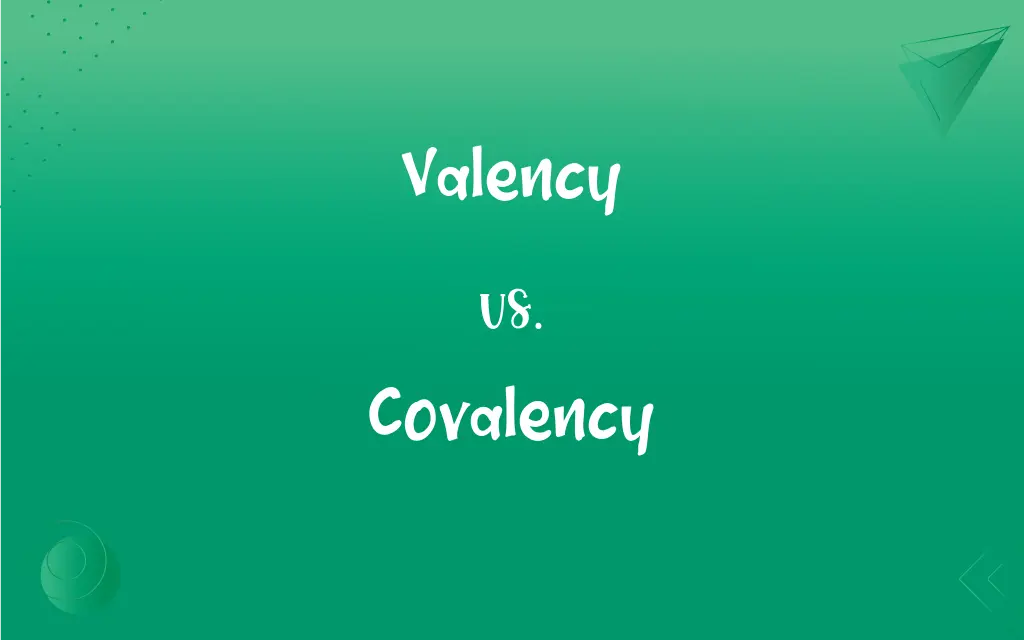Valency vs. Covalency: What's the Difference?
Edited by Aimie Carlson || By Harlon Moss || Updated on October 22, 2023
Valency refers to the combining capacity of an atom, while covalency denotes the number of electron pairs an atom can share with another atom.

Key Differences
Valency is a measure of an atom's ability to bond with other atoms, representing the total number of electrons an atom can lose, gain, or share to achieve a full outer shell. Covalency, on the other hand, specifically refers to the number of electron pairs an atom shares in covalent bonds.
While valency gives a broader perspective on how atoms can combine, either through ionic or covalent bonds, covalency is strictly related to covalent bonding. It's worth noting that while all atoms exhibit valency, covalency is pertinent only when discussing non-metallic atoms or those involved in covalent bonding.
To sum up, valency is a generic term encompassing an atom's overall combining power, whereas covalency zeroes in on the sharing of electron pairs in covalent bonds.
Comparison Chart
Definition
Combining capacity of an atom
Number of electron pairs an atom can share
Scope
Can pertain to both ionic and covalent bonds
Pertains only to covalent bonds
ADVERTISEMENT
Atoms Involved
Can be metals or non-metals
Primarily non-metals
Reflects
Total electrons an atom can lose, gain, or share
Electron pairs an atom shares in covalent bonds
Relation with Stability
Achieving a full outer shell
Achieving a stable configuration through shared pairs
Valency and Covalency Definitions
Valency
The combining power of an element.
Hydrogen has a valency of 1 as it can form one bond.
Covalency
Pertains to non-metallic atoms in covalent bonds.
The covalency of nitrogen in ammonia is 3.
ADVERTISEMENT
Valency
Indicates the number of bonds an atom can form.
Carbon, having a valency of 4, can form four bonds.
Covalency
A measure specific to covalent bonding.
Hydrogen's covalency is 1, as seen in molecular hydrogen.
Valency
Represents how atoms achieve a full outer electron shell.
Sodium loses an electron to achieve stability, reflecting its valency of 1.
Covalency
The number of electron pairs an atom shares.
Oxygen has a covalency of 2 in a water molecule.
Valency
The number of electrons an atom can lose, gain, or share.
Oxygen, with a valency of 2, can share two electrons.
Covalency
Reflects how atoms share electrons for stability.
Carbon exhibits a covalency of 4 in methane.
Valency
A concept relevant to both ionic and covalent bonding.
The valency of chlorine is 1, whether in ionic bonds with metals or covalent bonds with non-metals.
Covalency
The maximum number of covalent bonds an atom can form.
In carbon dioxide, carbon's covalency is 2 with each oxygen atom.
Valency
Variant of valence.
Covalency
The number of electron pairs an atom can share with other atoms.
Covalency
(chemistry) covalence
Covalency
Valence characterized by the sharing of electrons in a chemical compound; the number of pairs of electrons an atom can share
FAQs
Can metals exhibit valency?
Yes, metals can exhibit valency, typically losing electrons in ionic bonds.
Can covalency be zero?
No, if an atom forms a covalent bond, it must share at least one pair of electrons.
Are covalent bonds formed only between non-metals?
Primarily, covalent bonds are between non-metals, but exceptions exist.
What does valency represent?
Valency represents the combining capacity of an atom.
Can an atom's valency change?
Yes, certain elements can exhibit variable valency based on different conditions.
Is valency always a whole number?
Generally, valency is a whole number, but there are exceptions, especially in coordination compounds.
Can an atom have a different valency and covalency?
Yes, as valency considers all bonding types while covalency focuses only on covalent bonds.
Is valency related to the atomic number?
Not directly, but valency is influenced by the number of valence electrons, which relates to an atom's position in the periodic table.
Do all atoms have valency?
Nearly all atoms exhibit valency, except noble gases which generally don't form bonds due to their full outer shells.
What is the significance of covalency in molecules?
Covalency indicates the sharing of electrons, leading to the formation and properties of covalent molecules.
What does covalency focus on?
Covalency focuses on the number of electron pairs an atom shares in covalent bonds.
How is valency determined?
Valency is determined by the number of electrons an atom can lose, gain, or share to achieve a full outer shell.
How does valency relate to chemical reactions?
Valency helps predict how and with what atoms an element will react.
Does valency affect physical properties?
Indirectly, valency affects molecular structure, which in turn can influence physical properties.
How is covalency related to molecular geometry?
Covalency can influence molecular geometry by determining how many atoms are bonded to a central atom.
How is valency used in writing chemical formulas?
Valency helps determine the ratio in which atoms combine to form compounds.
Can covalency influence chemical reactivity?
Yes, the number and nature of covalent bonds can impact how a molecule reacts with other substances.
Which elements typically have a covalency of 1?
Hydrogen and halogens typically have a covalency of 1.
Why is covalency important in organic chemistry?
Covalency is crucial in organic chemistry as it deals predominantly with covalent bonds between carbon and other non-metals.
Is covalency always fixed for an element?
Generally, covalency remains consistent, but exceptions can arise in certain molecular structures.
About Author
Written by
Harlon MossHarlon is a seasoned quality moderator and accomplished content writer for Difference Wiki. An alumnus of the prestigious University of California, he earned his degree in Computer Science. Leveraging his academic background, Harlon brings a meticulous and informed perspective to his work, ensuring content accuracy and excellence.
Edited by
Aimie CarlsonAimie Carlson, holding a master's degree in English literature, is a fervent English language enthusiast. She lends her writing talents to Difference Wiki, a prominent website that specializes in comparisons, offering readers insightful analyses that both captivate and inform.
































































